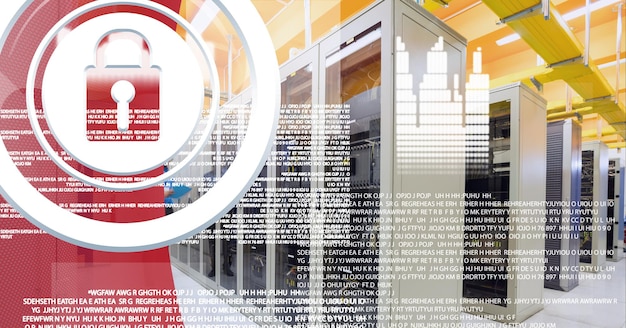Data Breach Costs Soaring: Reduce Your Company’s Risk by 20%

Data breach costs are escalating, but companies can mitigate their risk by 20% through proactive measures like robust cybersecurity protocols, employee training, and incident response planning, ultimately safeguarding their data and financial stability.
The escalating costs associated with data breaches are a growing concern for businesses of all sizes. Learn how to reduce your company’s risk by 20% with effective strategies and proactive measures in the face of data breach costs soaring.
Understanding the Rising Data Breach Costs
Data breaches are becoming increasingly prevalent and costly. Understanding the factors driving up these costs is crucial for businesses looking to protect their assets and reputation. Let’s explore why data breach costs are reaching new heights.
The Financial Impact of Data Breaches
The financial ramifications of a data breach extend far beyond immediate recovery efforts. Expenses can include legal fees, regulatory fines, customer notification costs, credit monitoring services, and lost business opportunities. The average cost of a data breach is in the millions, potentially crippling smaller organizations.
Reputational Damage and Customer Trust
A data breach can severely damage a company’s reputation and erode customer trust. Consumers are increasingly wary of sharing personal information with organizations that have a history of data breaches, leading to customer attrition and decreased revenue. Rebuilding trust after a breach can be a lengthy and expensive process.
- Direct costs (detection, escalation, notification, etc.).
- Indirect costs (downtime, lost productivity, reputation damage).
- Legal and regulatory penalties.
- Long-term costs (monitoring, remediation, prevention).
Understanding these factors paints a clear picture of the economic and reputational risks associated with data breaches. Businesses that proactively address these risks are better positioned to minimize their exposure and safeguard their future.

Assessing Your Company’s Current Cybersecurity Posture
Before implementing new security measures, it’s essential to evaluate your company’s existing cybersecurity posture. A thorough assessment will help you identify vulnerabilities and prioritize areas for improvement. Let’s look at how to effectively assess your cybersecurity readiness.
Conducting a Cybersecurity Risk Assessment
A risk assessment involves identifying potential threats, evaluating the likelihood and impact of those threats, and determining the appropriate security controls to mitigate the risks. This process should cover all aspects of your organization, including technology, processes, and people.
Identifying Vulnerabilities in Your Systems
Vulnerabilities are weaknesses in your systems that could be exploited by attackers. These weaknesses can range from outdated software and misconfigured firewalls to weak passwords and lack of employee training. Regular vulnerability scans and penetration testing can help you identify and address these issues.
- Inventory your assets (hardware, software, data).
- Identify potential threats (malware, phishing, insider threats).
- Assess vulnerabilities (weaknesses in your systems).
- Evaluate risk (likelihood and impact).
By understanding your organization’s current cybersecurity posture, you can develop a targeted plan to strengthen your defenses and reduce the risk of data breach costs soaring.
Implementing Robust Data Protection Measures
Once you’ve assessed your cybersecurity posture, the next step is to implement robust data protection measures. These measures should address all aspects of your organization’s IT infrastructure, from network security to data encryption. Let’s explore some key strategies for protecting your sensitive data.
Network Security and Firewall Configuration
Your network is the first line of defense against cyberattacks. Implementing strong network security measures, such as firewalls, intrusion detection systems, and virtual private networks (VPNs), can help prevent unauthorized access to your systems. Make sure your firewalls are properly configured and regularly updated.
Data Encryption and Access Controls
Data encryption protects your sensitive information by converting it into an unreadable format. Encryption should be used for both data in transit (e.g., when it’s being transmitted over the internet) and data at rest (e.g., when it’s stored on your servers). Access controls restrict access to sensitive data to authorized personnel only.
- Implement strong passwords and multi-factor authentication.
- Encrypt sensitive data at rest and in transit.
- Use access control lists to restrict access to data.
- Regularly update security software and patches.
By implementing these measures, you can significantly reduce the risk of data breaches and protect your organization’s valuable assets and minimize the data breach costs soaring.
Employee Training and Awareness Programs
Employees are often the weakest link in a company’s security chain. Training your employees to recognize and avoid phishing scams, malware attacks, and other cyber threats is crucial for protecting your organization. Let’s see why employee education is critical to cybersecurity.
Educating Employees on Phishing and Social Engineering
Phishing scams and social engineering attacks are designed to trick employees into revealing sensitive information or downloading malware. Training your employees to recognize these attacks and report them to IT is essential for preventing data breaches.
Promoting a Culture of Cybersecurity Awareness
Creating a culture of cybersecurity awareness involves making security a priority for all employees, not just the IT department. This can be achieved through regular training sessions, security newsletters, and internal communication campaigns. Employees should be encouraged to report suspicious activity and follow security best practices.
- Regular phishing simulations to test employee awareness.
- Training on password security and data handling.
- Awareness campaigns on emerging cyber threats.
- Clear reporting procedures for security incidents.
Investing in employee training and awareness programs is a cost-effective way to reduce the risk of human error and strengthen your overall cybersecurity posture, therefore reducing the increasing data breach costs for your company.

Developing an Incident Response Plan
Even with the best security measures in place, data breaches can still occur. Having a well-defined incident response plan is essential for minimizing the damage and restoring normal operations quickly. Let’s explore the key components of an effective incident response plan.
Creating a Step-by-Step Response Protocol
Your incident response plan should outline the steps to be taken in the event of a data breach, including who is responsible for each task and how to communicate with stakeholders. The plan should be tested regularly to ensure it’s effective.
Establishing Communication Channels
Effective communication is critical during a data breach. Establish clear communication channels for notifying employees, customers, law enforcement, and other stakeholders. Designate a spokesperson to handle media inquiries. Ensure clear reporting procedures for security incidents.
- Identification: Detecting and verifying a security incident.
- Containment: Isolating the affected systems to prevent further damage.
- Eradication: Removing the malware or other threats from the systems.
- Recovery: Restoring the systems to normal operation.
Having a proven incident response plan is super important and it can improve a company’s cyber resilience and lower the data breach costs soaring.
Regularly Reviewing and Updating Security Measures
The cyber threat landscape is constantly evolving, so it’s essential to regularly review and update your security measures. What worked a year ago may no longer be effective today. Let’s explore the importance of continuous improvement in cybersecurity.
Staying Ahead of Emerging Threats
Keep up-to-date with the latest cyber threats and vulnerabilities by subscribing to security newsletters, attending industry conferences, and participating in threat intelligence sharing programs. Use this information to update your security measures and train your employees.
Conducting Regular Security Audits and Penetration Testing
Regular security audits and penetration testing can help you identify weaknesses in your systems that could be exploited by attackers. These tests should be conducted by qualified professionals who can provide objective feedback and recommendations.
- Schedule regular security assessments.
- Prioritize updates based on risk level.
- Continuously improve security protocols.
- Stay informed about new threats and vulnerabilities.
By investing in these capabilities, companies can boost their cybersecurity defenses and greatly minimize the increasing data breach costs soaring in today’s environment.
| Key Point | Brief Description |
|---|---|
| 🛡️ Risk Assessment | Identify vulnerabilities and prioritize improvements. |
| 🔒 Data Encryption | Protect sensitive information via encryption techniques. |
| 👨🏫 Employee Training | Train employees to recognize and avoid cyber threats. |
| 🚨 Incident Response | Establish steps to minimize damage and restore operations. |
Frequently Asked Questions (FAQ)
▼
The primary drivers of data breach costs include detection efforts, lost business, notification expenses, regulatory fines, and litigation. The specific cost varies based on the type of data compromised and the scale of the breach.
▼
A company can assess its cybersecurity posture by conducting regular risk assessments that identify potential threats, evaluate vulnerabilities, and determine appropriate measures to address these risks. Penetration testing can also help expose weaknesses.
▼
Employee training is critical because employees are often the first line of defense against cyber threats like phishing and malware. Educating them helps reduce the likelihood of human error that could lead to a data breach.
▼
Key components of an effective incident response plan include a step-by-step protocol, clear communication channels to notify stakeholders, containment strategies, and procedures for eradication of threats and recovery of normal operations.
▼
A company should regularly review and update security measures, ideally on a continuous basis, due to the evolving nature of cyber threats. Regular security audits and penetration testing are crucial for identifying emerging vulnerabilities.
Conclusion
In conclusion, as data breach costs continue to soar, proactive measures are essential for companies to reduce their risk exposure. By implementing robust cybersecurity protocols, conducting regular risk assessments, investing in employee training, and developing a comprehensive incident response plan, businesses can significantly minimize the financial and reputational impact of data breaches and protect their valuable assets.





